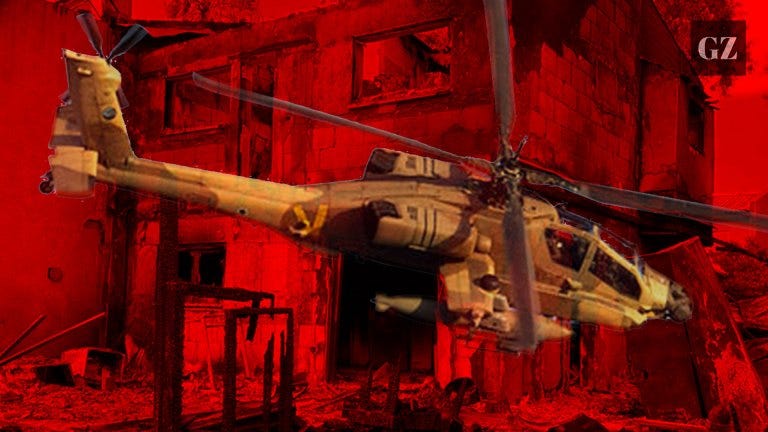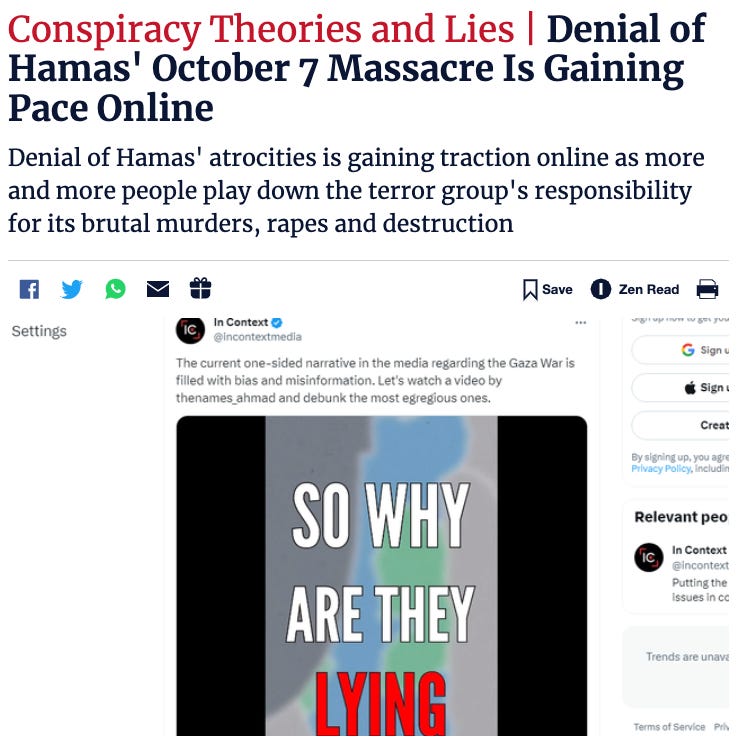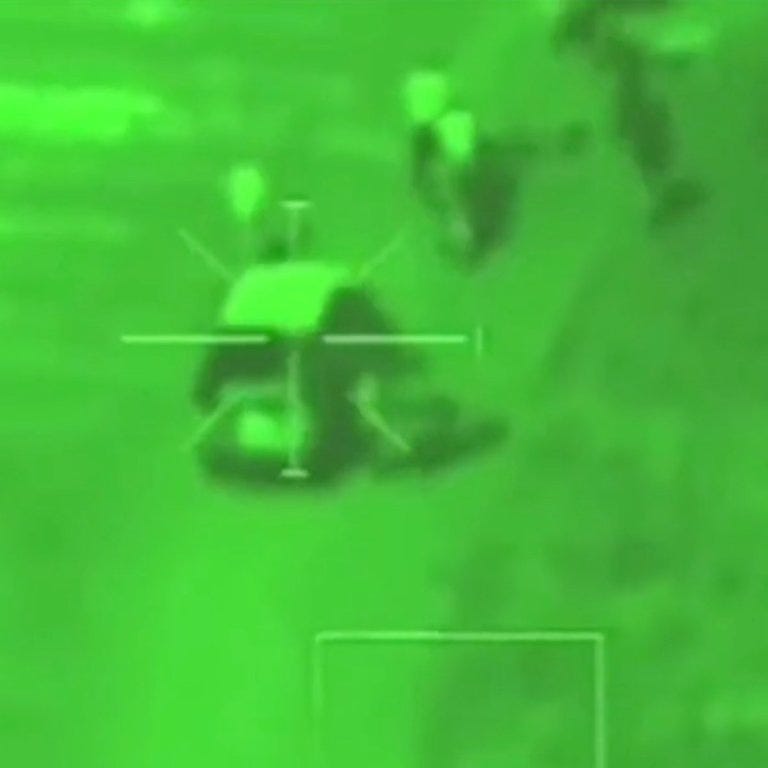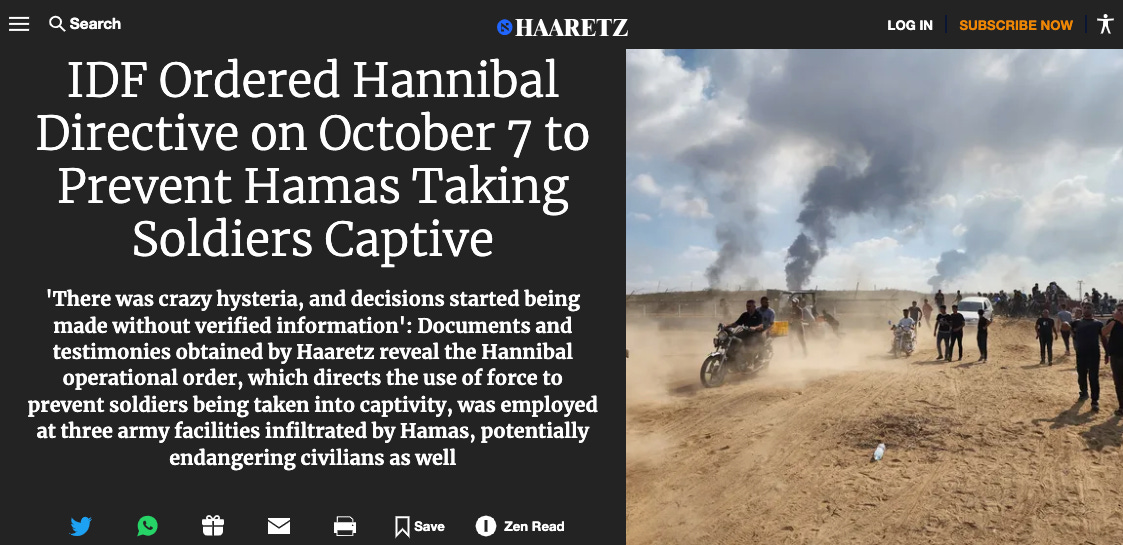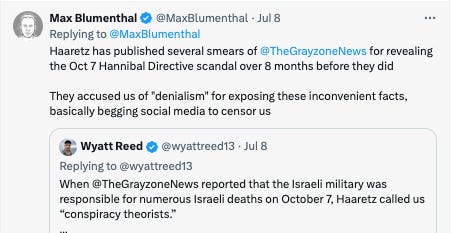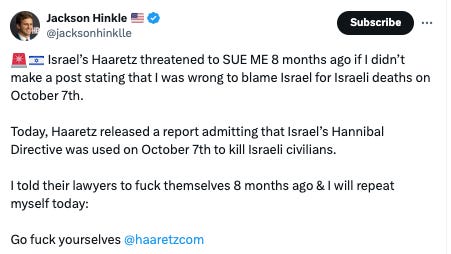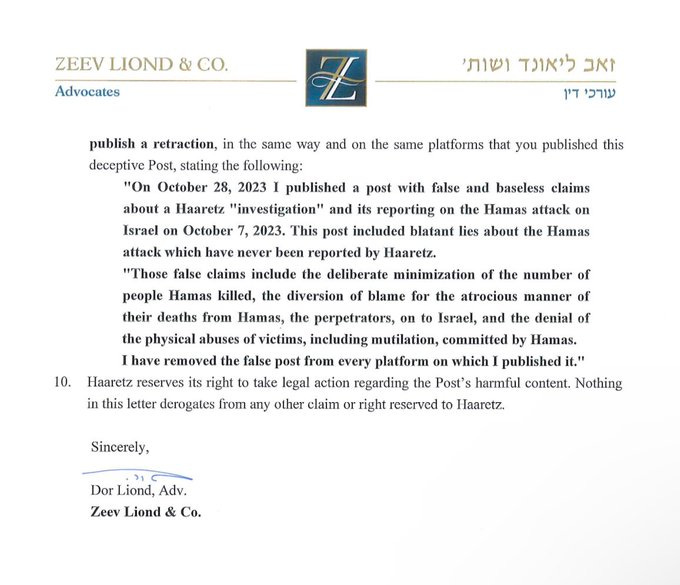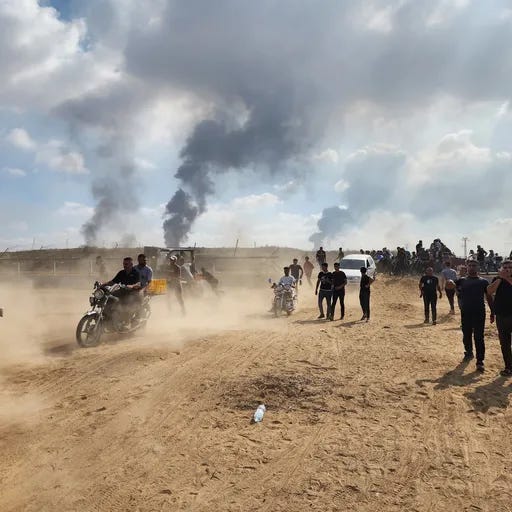
Discover more from Seemorerocks
I KNEW what had happened on October 7 almost straight away because of this video
That was followed up with this conversation with Bret Weinstein
Since then the Grayzone and Max Blumenthal have done excellent work to show that the Israeli’s killed their own on that date.
This, on October 7
October 7 testimonies reveal Israel’s military ‘shelling’ Israeli citizens with tanks, missiles
Israel’s military received orders to shell Israeli homes and even their own bases as they were overwhelmed by Hamas militants on October 7. How many Israeli citizens said to have been “burned alive” were actually killed by friendly fire?
This was the response of Haaretz on the same date
Denial of the atrocities of October 7 or attempts to downplay Hamas’ role have been gaining traction on social media – to the point that some Israelis are following suit, even lawmakers.
The false posts mix lies and baseless allegations – against the backdrop of antisemitism and anti-Israel stances. Conspiracy theorists don’t claim that the entire event was fabricated, but they say the death toll is much lower than reported.
November 21
Haaretz confirms Grayzone reporting it dismissed as ‘conspiracy’ showing Israel killed own festivalgoers
Haaretz has yet to admit it jumped the gun when it dismissed The Grayzone’s Max Blumenthal as a ‘conspiracy theorist’ for documenting crucial evidence that Israeli forces killed Israelis on October 7. But new reports by the same outlet show we were right all along.
But yesterday, Haaretz confirmed everything that had been reported, that they had earlier denounced as “anti-semitism” with the article
These were responses yesteray from yesterday:
And Haaretz threatened to sue commentator, Jackson Hinkle:
Here is the Haaretz article":
IDF Ordered Hannibal Directive on October 7 to Prevent Hamas Taking Soldiers Captive
'There was crazy hysteria, and decisions started being made without verified information': Documents and testimonies obtained by Haaretz reveal the Hannibal operational order, which directs the use of force to prevent soldiers being taken into captivity, was employed at three army facilities infiltrated by Hamas, potentially endangering civilians as well
Gaza Division operations and airstrikes in the first hours of October 7 were based on limited information. The first long moments after the Hamas attack was launched were chaotic. Reports were coming in, with their significance not always clear. When their meaning was understood, it was realized that something horrific had taken place.
Communication networks could not keep up with the flow of information, as was the case for soldiers sending these reports. However, the message conveyed at 11:22 A.M. across the Gaza Division network was understood by everyone. "Not a single vehicle can return to Gaza" was the order.
At this point, the IDF was not aware of the extent of kidnapping along the Gaza border, but it did know that many people were involved. Thus, it was entirely clear what that message meant, and what the fate of some of the kidnapped people would be.
This was not the first order given by the division with the intent of foiling kidnapping even at the expense of the lives of the kidnapped, a procedure known in the army as the "Hannibal procedure."
Documents obtained by Haaretz, as well as testimonies of soldiers, mid-level and senior IDF officers, reveal a host of orders and procedures laid down by the Gaza Division, Southern Command and the IDF General Staff up to the afternoon hours of that day, showing how widespread this procedure was, from the first hours following the attack and at various points along the border.
'Unlawful, unethical, horrifying': IDF ethics expert on controversial Hannibal Directive
Who is the IDF general who ordered tank fire on a kibbutz home with 13 hostages inside?
‘Similar to a virus’: Disinformation becomes deadly new front in Israel-Hamas war
Haaretz does not know whether or how many civilians and soldiers were hit due to these procedures, but the cumulative data indicates that many of the kidnapped people were at risk, exposed to Israeli gunfire, even if they were not the target.
At 6:43 A.M., at which time rocket barrages were launched at Israel and thousands of Hamas operatives were attacking army strongholds and the division's observation and communications capabilities, the division's commander Brig. Gen. Avi Rosenfeld declared that "the Philistines have invaded."
This is the procedure when an enemy invades Israeli territory, upon which a division commander can assume extraordinary authority, including the employment of heavy fire inside Israeli territory, in order to block an enemy raid.
A very senior IDF source confirmed to Haaretz that the Hannibal procedure was employed on October 7, adding that this was not used by the divisional commander. Who did give the order? This, said the source, will perhaps be established by post-war investigations.
In any case, says a defense official who is familiar with the October 7 operations at the Gaza Division, in the morning hours "no one knew what was going on outside." He says that Rosenfeld was in the war room, not emerging, "while outside a world war was raging."
"Everyone was shocked by the number of terrorists who had penetrated the base. Even in our nightmares, we didn't have plans for such an attack. No one had a clue about the number of people kidnapped or where army forces were. There was crazy hysteria, with decisions made without any verified information," he continued.
One of these decisions was made at 7:18 A.M., when an observation post at the Yiftah outpost reported that someone had been kidnapped at the Erez border crossing, adjacent to the IDF's liaison office. "Hannibal at Erez" came the command from divisional headquarters, "dispatch a Zik." The Zik is an unmanned assault drone, and the meaning of this command was clear.
This wasn't the last time that such an order was heard over the communications network. Over the next half hour, the division realized that Hamas terrorists had managed to kill and abduct soldiers serving at the crossing and at the adjacent base. Then, at 7:41 A.M., it happened again: Hannibal at Erez, an assault on the crossing and the base, just so that no more soldiers be taken. Such commands were given later as well.
The Erez border crossing was not the only place this happened. Information obtained by Haaretz and confirmed by the army shows that throughout that morning, the Hannibal procedure was employed at two other locations penetrated by terrorists: the Re'im army base, where the divisional headquarters were located, and the Nahal Oz outpost in which female spotters were based. This did not prevent the kidnapping of seven of them or the killing of 15 other spotters, as well as 38 other soldiers.
Over the next few hours, division headquarters started putting the pieces of the puzzle together, realizing the extent of the Hamas attack, but missing the invasion of Kibbutz Nir Oz, which the first army forces reached only after the terrorists had left. Regarding the frequency of employing the Hannibal procedure, it seems that nothing changed. Thus, for example, at 10:19 A.M. a report reached divisional headquarters indicating that a Zik had attacked the Re'im base.
Three minutes later, another such report arrived. At that time, Shaldag commando forces were already on the base fighting the terrorists. To this day, it's not clear whether one of them was hurt in the drone attack. What is known is that over the communications network there was a message asking everyone to make sure no soldier was outdoors on the base, since IDF forces were about to enter and drive out or kill remaining terrorists.
The decision to conduct attacks inside outposts, says a senior defense official, will haunt senior commanders all their lives. "Anyone making such a decision knew that our combatants in the area could be hit as well."
But such attacks took place, it turns out, not only inside outposts or bases. At 10:32 A.M., a new order was issued, according to which all battalions in the area were ordered to fire mortars in the direction of the Gaza Strip. Internal discussions in the army noted that this order, attributed to Brig. Gen. Rosenfeld, was heavily criticized, since at that time, the IDF did not have a complete picture of all the forces in the area, including soldiers and civilians. Some of these were in open areas or in woods along the border, trying to hide from the terrorists.
At that point, the army did not know the number of people who had been kidnapped. "We thought they numbered dozens at that stage," a military source told Haaretz. Firing mortars at the Gaza Strip would endanger them as well. Furthermore, another order given at 11:22 A.M., according to which no vehicle would be allowed to return to Gaza, took this a step further.
"Everyone knew by then that such vehicles could be carrying kidnapped civilians or soldiers," a source in Southern Command told Haaretz. "There was no case in which a vehicle carrying kidnapped people was knowingly attacked, but you couldn't really know if there were any such people in a vehicle. I can't say there was a clear instruction, but everyone knew what it meant to not let any vehicles return to Gaza."
A new development occurred at 2:00 P.M. All the forces were instructed not to exit border communities toward the west, in the direction of the border, with an emphasis on not chasing terrorists. At that point, the border area was under intense fire, directed at anyone in that area, making it a danger zone.
"The instruction," says the source in Southern Command, "was meant to turn the area around the border fence into a killing zone, closing it off toward the west."
At 6:40 P.M., military intelligence believed that many terrorists were intending to flee together back to the Gaza Strip, in an organized manner. This was near Kibbutz Be'eri, Kfar Azza and Kissufim. Following this, the army launched artillery raids at the border fence area, very close to some of these communities. Shortly afterwards, shells were fired at the Erez border crossing. The IDF says it is not aware of any civilians being hurt in these bombardments.
Unrestricted fire
One case in which it is known that civilians were hit, a case that received wide coverage, took place in the house of Pessi Cohen at Kibbutz Be'eri. 14 hostages were held in the house as the IDF attacked it, with 13 of them killed. In the coming weeks, the IDF is expected to publish the results of its investigation of the incident, which will answer the question of whether Brig. Gen. Barak Hiram, the commander of Division 99 who was in charge of operations in Be'eri on October 7, was employing the Hannibal procedure. Did he order the tank to move ahead even at the cost of civilian casualties, as he stated in an interview he gave later to the New York Times?
Over all the months that have passed, the IDF has refused to say whether this procedure was employed against civilians who had been taken hostage. It now seems that even if the answer is positive, the question may have been only a partial one. The actions of Hiram may have simply been congruent with the way the IDF operated that day.
As far as Haaretz knows, even at 9:33 P.M. this was still the situation on the ground. At that time, there was a further order from Southern Command: close off all the border area with tanks. In fact, all forces in the area received permission to open fire at anyone approaching the border area, without any restrictions.
The IDF spokesman responded by saying that "the army has been fighting for six months at high intensity on several fronts, focused on attaining the war's objectives. In tandem, the IDF has begun conducting internal investigations of what transpired on October 7 and the preceding period. The aim of these investigations is to learn and to draw lessons which could be used in continuing the battle. When these investigations are concluded, the results will be presented to the public with transparency."
In addition to the Grayzone, al Jazeera did an excellent documentary on October 7 three months ago.
This is an extract from al-Jazeera
Here is the original documentary
October 7 | Al Jazeera Investigations
Hamas’s incursion into Israel on October 7 transformed the politics of the Middle East. Al Jazeera’s Investigative Unit (I-Unit) has carried out a forensic analysis of the events of that day – examining seven hours of footage from CCTV, dashcams, personal phones and headcams of dead Hamas fighters, and drawing up a comprehensive list of those killed.
In October 7, the I-Unit reveals widespread human rights abuses by Hamas fighters and others who followed them through the fence from Gaza into Israel.
But the investigation also found that many of the worst stories that came out in the days following the attack were false. This was especially true of atrocities that were used repeatedly by politicians in Israel and the West to justify the ferocity of the bombardment of the Gaza Strip, such as the mass killing of babies and allegations of widespread and systematic rape.
In particular the I-Unit reveals that claims by the Israel Defence Force that it found 8 burned babies at a house in Kibbutz Be’eri were entirely untrue. There were no babies in the house and the 12 civilians inside were killed by Israeli forces when they stormed the house.
This was one of a number of incidents where the police and army appear to have killed Israeli citizens.
October 7 is a deep dive into the events that led to the deaths of tens of thousands of people, the significance of which will reverberate for decades.
“age-restricted”
See HERE
Here is commentary from Richard Medhurst
Subscribe to Seemorerocks
This is where I post articles by me that might otherwise get buried.



